Monetary Policy Midterm
1/258
There's no tags or description
Looks like no tags are added yet.
Name | Mastery | Learn | Test | Matching | Spaced |
|---|
No study sessions yet.
259 Terms
what is the central Bank responsible for
controlling the availability of money and credit in a country's economy.
how does the central bank control the availability of money
monetary policy, primarily by adjusting short-term interest rates
what does adjusting short-term interest rates do
stabilize economic growth and inflation
what is a profitable business for the central bank
printing money is a profitable business for the central bank, as the cost of printing a bill is only a few cents.
what does the ability to create money mean for the CB
CB can make loans even when no one else can
what are the key roles of the CB today
1. To provide loans during times of financial stress,
2. To manage the payments system, and
3. To oversee commercial banks and the financial system
what does the fact that all banks have an account at the CB mean
it is the natural place for interbank payments to be made
what is the CB not?
does not control securities markets (might moniter and participate in stock/bond market)
does not control government’s budget (congress-fiscal policy)
only acts as treasury’s bank
what is the job of the CB
to improve general economic welfare by managing and reducing systematic risk
5 objectives of a modern CB
low, stable inflation
when high, growth is low
high stable growth
stable growth is higher than unstable growth
financial system stability
necessity for economy to efficiently operate
stable interest rates
volatility creates risk for lenders and borrowers
stable exchange rates
variable rates make revenues from foreign countries and cost of purchasing imported goods hard to predict
what is a time consistent policy
one where a future policymaker lacks the opportunity or the incentive to renege. A policy lacks time consistency when a future policymaker has both he means and the motivation to break the commitment
4 principles of CB design
independence
to keep inflation low, monetary decisions must be made free of political influence
accountability and transparency
policymakers must be accountable to the public they serve and clearly communicate their objectives, decisions, and methods
policy framework
must clearly state their policy goals and tradeoffs among them
decision making committee
pooling the knowledge of a # of people yields better decisions than by an individual
effective crisis response requires clear chain of command
what is the federal reserve system composed of
– 12 regional Federal Reserve Banks, distributed throughout the country
– A central governmental agency, called the Board of Governors of the Federal Reserve
System, in Washington, D.C.
describe the federal reserve banks
part public and private
federally chartered banks and private, nonprofit organizations
owned by the commercial banks in their districts
who oversees the federal reserve banks
their own board of directors and the Board of Governors
how many members are on the board of directors for each reserve bank
9
how are the 9 reserve bank board of directors elected
Six directors are elected by the commercial bank members of the Reserve Bank
Three directors representing the Reserve Bank
Three represent the public.
The Boards of Governors appoint the remaining three directors.
how is the president of each reserve bank appointed
for a 5-year term by bank board of directors with the approval of the board of governors
describe the makeup of the Board of governors
7 members called governors
appointed by the president and confirmed by the Senate
14-yr terms
long terms intended to protect the board form political pressure
staggered limiting any individual president’s influence over the membership
a chairperson and 2 vice chairpersons
appointed by president from 7 governors
4 year renewable term
what are the duties of the board of governors
Set the reserve requirement
Approve or disapprove discount rate recommendations
Approve changes in the interest rate paid on excess reserves (IOER rate)
Rule-writing agency for consumer credit protection laws
approve bank merger applications
supervise & regulate reserve banks
regulate & supervise banking system with reserve banks
invoke emergency powers (curtailed by Dodd-Frank Act) to lend to nonbanks
analyze financial and economic conditions
collect & publish detailed stats
describe the makeup of the federal open market committee (FOMC)
chair of the BoG chairs the FOMC
committee’s vice chair is president of Fed bank of NY
all participate in meetings
only 5 of 12 bank presidents vote at any one time
what does the FOMC choose to do
control the federal funds rate-influencing real growth
what does FOMC stand for
federal open market committee
what is the federal funds rate
rate banks charge each other for unsecured overnight loans on their excess deposits at the fed
-rate that banks lend reserves to each other overnight-determined in market, not controlled by fed
-influences other interest rates in economy, as well as, spending and investing made by consumers and producers
how many times does the FOMC meet
8 a year (can change policy over the phone in times of crisis)
what is the purpose of the FOMC meeting
to decide on the target range of the federal funds rate and scale and mix of assets to acquire
-agrees on how to communicate policies to the public, including any forward guidance
what is forward guidance
a monetary policy tool that central banks use to communicate their plans for interest rates. The goal of forward guidance is to influence market expectations of future interest rates
why does the FOMC not engage in financial market transactions required to keep the market FFR near the target or manage the fed’s portfolio
that’s the job of the SOMA (system open market account manager) who works for NY fed
describe a FOMC meeting
a formal proceeding that includes staff reports and discussion comments by all the meeting’s participants.
After adjournment, the chair holds a press conference to discuss the FOMC’s
assessment and policy plans.Three weeks after the meeting, detailed minutes summarizing the deliberations are released on the FOMC’s public website.
1. The chair is the voice of the Fed.
2. The governors make up a majority of the committee.
3. Aside from the quarterly projections of FOMC members, the most important information distributed to all committee members is the Tealbook
4. The chair sets the agenda for FOMC meetings, determines the order in which people speak, and proposes the FOMC policy statement.
5. Committee members observe a blackout period from a week prior to a week after the meeting.
who is the most important member of the FOMC
the chair
what are the checks on the FOMC chair
even 2 dissents on an FOMC votes are unusual
3 dissent would raise doubts about the chair’s leadership
describe the role of the chair of the Board of governors
most powerful person in the fed system
effectively controls FOMC meetings and monetary policy
appointed to 4 year term by US president (subject to senate confirmation)
must be a governor
elected as chair of FOMC
describe the role of the other members of the board of governors
supervise and regulate part of financial industry
all voting members of the FOMC
appointed by president to 14 yr terms subject to senate confirmation
2 vice chairs must be members of board of governors
one is designated for supervision
describe the role of the Federal Reserve Bank of NY
runs biggest and most important reserve bank
where monetary policy operations are carried out and much of fed’s work for treasury is done
provides services to commercial banks in district
appointed by nonbanking members of bank’s board of directors, with approval of BoG
5 yr term
vice char of FOMC
describe the role of the presidents of the 11 other federal reserve banks
provide services to commercial banks in their district
all participate in every FOMC meeting
serve 1 yr terms as voting members of the FOMC on rotating basis
describe the structure and organization of the federal reserve system
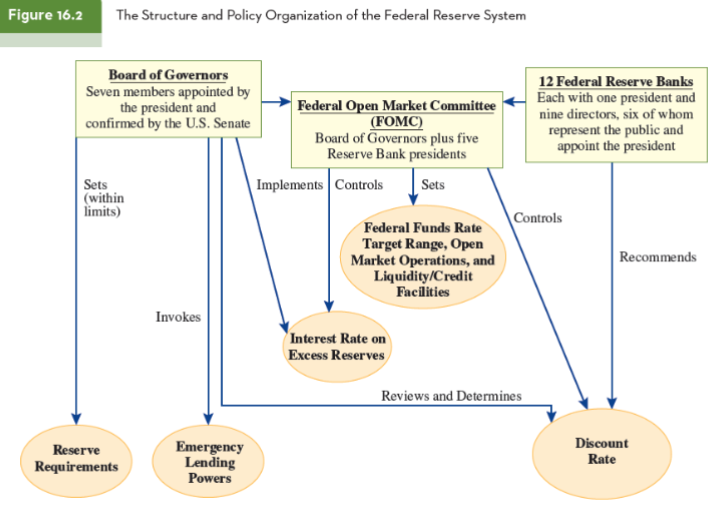
3 criteria for judging a CB’s independence
budgetary independence
irreversible decisions
long terms in office
what are the objectives set by congress for the fed
Maintain long run growth of the monetary and credit aggregates commensurate with
the economy’s long run potential to increase productionPromote effectively the goals of maximum employment, stable prices, and moderate
long-term interest rates.
purchases made in euros and monetary policy is who’s job
european central bank
european system of central banks (ESCB)
composed of national central banks (NCBs) in the 28 countries in the EU
eurosystem
The ECB and the NCBs of the 19 countries that participate in the monetary union make up
They share a common currency (euro) and common monetary policy (set by the ECB)
how does the eurosystem mirror the federal reserve system
– There is a six-member Executive Board of the ECB, similar to the Board of Governors
– The National Central Banks play many of the same roles as the Federal Reserve Banks
– The Governing Council formulates monetary policy as the FOMC does
–The Executive Board has a president and a vice president who play the same role as the
Fed’s Board of Governors
how are the ECB executive board members appointed
by a committee composed of the heads of state of the countries that participate in the monetary union
how do the ECB and NCB perform the traditional operations of a CB
– They use interest rates to control the availability of money and credit in the economy, and
– They are responsible for the smooth operation of the payments system and the issuance of currency.
• The National Central Banks continue to serve as bankers to the banks and governments in their countries
differences between the fed and the ECB
1. The implementation of monetary policy is accomplished at all the national central banks,
rather than being centralized as in the U.S.
2. The ECB’s budget is controlled by the National Central Banks, not the other way around.
3. The ECB still provides a large volume of reserves through collateralized lending to the
banks, in addition to sales and purchases of securities
describe the governing council of the eeurosystem
composed of the six Executive Board members and the governors
of the 19 central banks in the euro area.
• Meetings are held eight times a year.
• Decisions are made by formal votes of theCouncil but the specific votes are not
published.
– Ensure that Governing Council members focus onsetting policy for the euro area as a whole
how is the ECB’s independence assured
1. There are terms of office.
2. The ECB’s financial interests must remain separate from any political organization.
3. The treaty states explicitly that the Governing Council cannot take instructions from any
government, so its policy decisions are irreversible.
what are some of the information distributed by the ECB
– A weekly balance sheet
– A monthly statistical bulletin
– An analysis of current economic conditions
– Biannual forecasts of inflation and growth
– Research reports relevant to current policy
– An annual report
what does the governing council of the ECB target
a short term interest rate on interbank loans, providing forward guidance, and providing liquidity
what does the governing council do to be transparent
• Following each of the Governing Council’s monthly meetings, the president and vice president of the ECB hold a news conference.
• A transcript of their remarks is posted on the ECB’s website soon afterward
• In 2015, the ECB began issuing a written account comparable to the minutes published by the FOMC
– The ECB doe not detail the votes of the Governing Council, nor keep verbatim transcripts
the treaty of maastricht places a priority on what
price stability-including objective of sustainable and non-inflationary growth
2 parts
a numerical definition of price stability
the Governing council announces its intention to focus on a broad-based assessment of the outlook for future prices with money playing a prominent role
what does the ECB’s governing council define price stability as
inflation rate of close to, but less then 2% based on euro-area-wide measure of consumer prices
– This is the harmonized index of consumer prices (HICP) and is similar to the CPI.
– It is the average of retail price inflation in all the countries of the monetary union, weighted by the size of their gross domestic products.
describe the CB’s balance sheet
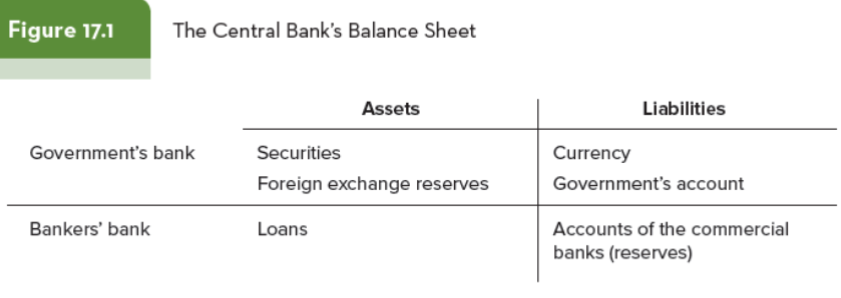
what is the primary asset of the CB
securities
explain the asset of securities
– Traditionally, the Fed exclusively held Treasury securities, which are virtually free of
default risk.
– During the 2007-2009 crisis, the central bank chose to acquire a variety of risky assets.
– The quantity of securities it holds is controlled through purchases and sales known as open
market operations
explain the asset of foreign exchange reserves
-central bank’s and government’s balances of foreign currency
– These are held in the form of bonds issued by foreign governments.
– These reserves are used in foreign exchange interventions when officials attempt to change
the market values of various currencies.
explain the CB asset of loans
-usually extended to commercial banks
– In 2008 and 2009, the Fed made substantial loans to nonbanks as well.
• Discount loans are the loans the Fed makes when commercial banks need short-term cash.
• Through its liquid securities holdings, the Fed controls the federal funds rate and the
availability of money and credit
-like note receivables
describe the CB liability of currency
-Nearly all CBs have monopoly on issuance of currency used in everyday transaction
– Currency circulating in the hands of the nonbank public is the principal liability of
most central banks.
describe the CB liability of the government’s account
-governments need bank account like the rest of us
– The central bank provides the government with an account into which the government
deposits funds (mostly tax revenue) and from which the government makes payments.
– By shifting funds between its accounts at commercial banks and the Fed, the Treasury
usually keeps its account balance at the Fed fairly constant
describe the CB liability of commercial bank accounts (reserves)
– Commercial bank reserves are the sum of two parts: Deposits at the central bank, plus the
cash in the bank’s own vault.
– In the same way that you can take cash out of a commercial bank, the bank can withdraw its
deposits at the central bank.
• Vault cash is part of reserves.
– Reserves are assets of the commercial banking system and liabilities of the central bank.
of the CB’s liabilities, which are the most important in determining the quantity of money and credit in the economy
bank reserves-CBs run their monetary policy operations through changes in these reserves
what are the 2 types of reserves
Required reserves that banks must hold
Excess reserves, which banks hold voluntarily
what is the importance of the disclosure of the CB’s own financial condition
• Every central bank publishes a statement of the bank’s own financial condition.
• Without public disclosure of the level and change in the size of foreign exchange reserves
and currency holdings, it is impossible for us to tell whether the policymakers are doing their
job properly.
• Publication of the balance sheet is an essential aspect of central bank transparency.
• A sign of trouble is misrepresentation of the central bank’s financial position
what is the monetary base
currency in the hands of the public and reserves in the banking system
privately held liabilities of CB
called high-powered money
the CB can control the size of the monetary base
when the monetary base increases by a dollar, the quantity of money typically rises by several dollars
can policymakers change the number of assets/liabilities without asking
yes-the CB can simply buy assets and create liabilities to pay for them-can increase the size of its balance sheet as much as it wants
what is the difference between a purchase you make and one the CB makes
– To pay for the bond, the central bank writes a $ 1 million check payable to the bond dealer.
– The dealer’s commercial bank account is credited with $1 million when the check is deposited.
– The commercial bank then sends the check back to the central banks.
– The central bank credits the reserve account of the bank presenting the $1 million.
what 4 transactions taken by the CB change the size of its balance sheet
1. Open Market Operation
– Buying or selling a security initiated by the central bank.
2. Foreign Exchange Intervention
– Buy or sell foreign exchange reserves initiated by the central bank.
3. Extend a discount loan
– Initiated by commercial banks.
4. Decision by an individual to withdraw cash from their bank
– Initiated by the nonbank public
when the value of an asset on the balance sheet increases, 1 of 2 things happens so the net change can be 0:
the value of another asset decreases
the value of a liability rises by the same amount
what should the fed aim for in their balance sheet
minimal liquidity, maturity and credit risk
what are open market operations
when the fed buys or sells securities in financial markets
describe an example of open market operations
• The Fed transfers $1 billion into the reserve account of the seller, called a T-account.
• The Fed’s assets and liabilities both go up $1 billion, increasing the monetary base by the same amount.
• Both the $1 billion in securities and in reserves are banking system assets.
• Notice that the reserves are an asset to the banking system but a liability to the Fed.
– This is similar to the balance in your bank account is your asset, but it is your bank’s
liability.
• If the Fed sells a U.S. Treasury bond through an open market sale, the impact on
everyone’s balance sheet is reversed

describe an example of foreign exchange intervention
• What if the U.S. Treasury instructs the Fed to buy $1 billion worth of euros.
– They buy German government bonds, denominated in euros, from foreign exchange departments of large commercial banks and pay for them with dollars.
• The $1 billion payment is credited directly to the reserve account of the bank from which the
bonds were bought.
– This has a similar effect on the balance sheet as the open market operation
• The Fed’s assets and liabilities both rise by $1 billion, and the monetary base expands with
them.
• In both cases, the banking system’s securities portfolio falls by $1 billion and reserves balances rise by an equal amount.

describe the balance sheet change of discount loans
• Commercial banks ask for loans, the Fed does not force them.
• A borrowing bank must provide collateral.
– This usually takes the form of U.S. Treasury bonds, but the Fed has been willing to accept a
broad range of securities and loans as collateral.
• This changes the balance sheet of both institutions.
• For the borrowing bank, it is a liability matched by an offsetting increase in the level of its reserve account.
• For the Fed, the loan is an asset that is created in exchange for a credit to the borrower’s reserve account.
• The extension of credit to the banking system raises the level of reserves and expands the monetary base

what three balance sheets does a cash withdrawal involve
the non bank public
the banking system
the central bank
explain the change in the CB’s balance sheet due to a cash withdrawal
• Because the Fed stands ready to exchange reserves for currency on demand, it does not
control the mix between the two.
– The nonbank public, those who hold cash, controls that.
• When you take cash from an ATM, you are changing the Fed’s balance sheet.
– By moving your own assets out of your bank and into currency, you force a shift from
reserves to currency on the Fed’s balance sheet.
• Your assets shift from checkable deposits to cash with no change in liabilities.
• Cash inside the bank, vault cash, counts as bank reserves.
– By withdrawing cash from your bank, you decreased the banking system’s reserves.
– This is a change in the bank’s T-account.
• For the Fed, the change comes in the composition of the Fed’s liabilities.
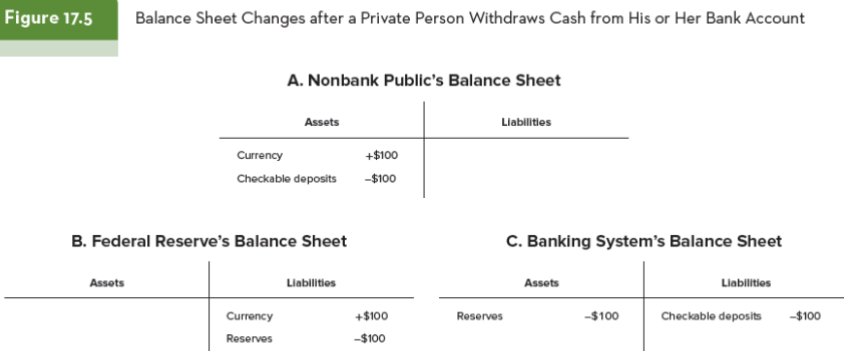
which changes in the balance sheet are done at the discretion of the central bank
open market operations and foreign exchange interventions
the level of discount borrowing is decided by who
the commercial banks
who decides how much currency to hold
the nonbank public
table of changes to CB balance sheet
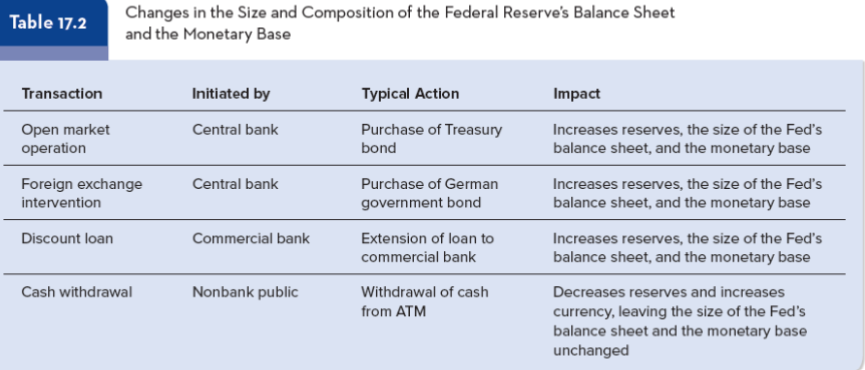
who controls the monetary base
central bank
why is it called a monetary base
central bank liabilities form the base on which the supplies of money and credit are built
what are the multiples of the monetary base
M1 & M2 (broader measure of money)
what is m1 and m2
the money we think of as available for transactions
can the nonbank public create and destroy the monetary base
no only the fed can but the nonbank public can determine how much of it ends up as reserves in the banking system and how much in currency
deposit expansion in a system of banks

deposit expansion multiplier
– That is the increase in commercial bank deposits following a one-dollar open market purchase.
– This continues to assume there are no excess reserves and no changes in the amount of
currency help by the nonbank public.
the quantity of money in the economy depends on
the monetary base (controlled by fed)
the reserve requirement (reserve amount in banks required by the fed)
bank’s desire to hold excess reserves
the nonbank’s public demand for currency (demand for cash withdrawals)
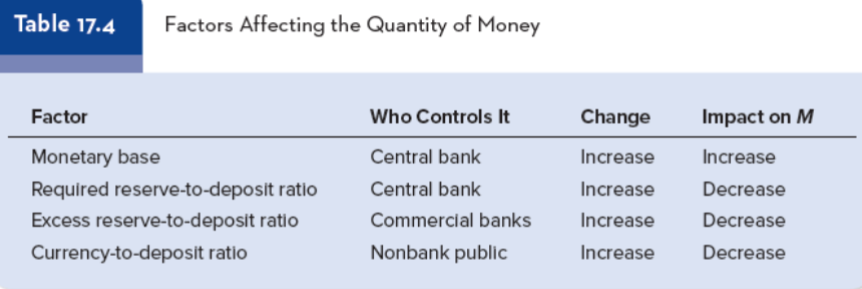
what is the impact on the quantity of money if the monetary base increases
quantity of money increases
what is the impact on the quantity of money if an increase in either the reserve requirement or bank’s excess reserve holding
reduces money
what is the impact on the quantity of money when an individual withdraws cash
they increase the currency in the public and decreases reserves
the decline in reserves creates a multiple deposit contraction
the money supply contracts
what are the factors affecting the quantity of money change over time
– Market interest rates affect the cost of holding both excess reserves and currency.
– As interest rates increase, we expect to see {ER/D} and {C/D} fall.
• This increases the money multiplier and the quantity of money
limits on the CB’s ability to control the quantity of money
• The money multiplier is just too variable.
• The relationship between the monetary base and the quantity of money is not something
that a central bank can exploit for short-run policy purposes.
• Interest rates have become the monetary policy tool of choice.
• In a financial crisis, other balance-sheet tools help address liquidity needs and market
disruptions more directly.
quantitative easing
massive expansion of reserves
what is the money multiplier
1/r where r is the reserve ratio (% of reserves mandated by fed for banks to keep)
conventional policy tools/instruments to steady the financial system
– The target range for the federal funds rate
– The interest rate on excess reserves (IOER rate)
– The rate for discount window lending (discount rate)
–reserve requirement
unconventional policy tools
– Massive purchases of risky assets in fragile markets
– Communicating its intent to keep interest rates low over an extended period (forward guidance)
prior to the financial crisis, what was the FOMC’s primary policy tool
target federal funds rate
target federal funds rate is set by what
the FOMC and the market federal funds rate where transactions between banks take place
what did discrepancies between actual and desired reserves do
-gave rise to market for reserves
-some banks can lend out excess reserves
-some banks will borrow to cover a shortfall
what would banks need to do without market for reserves
hold substantial quantities of excess reserves as insurance against shortfalls